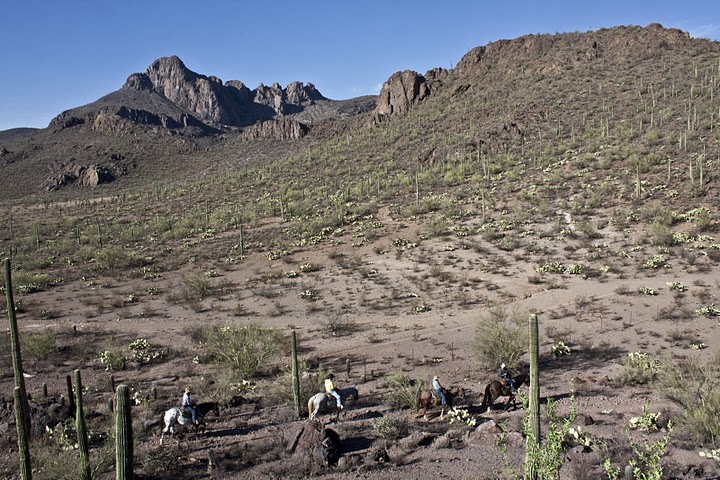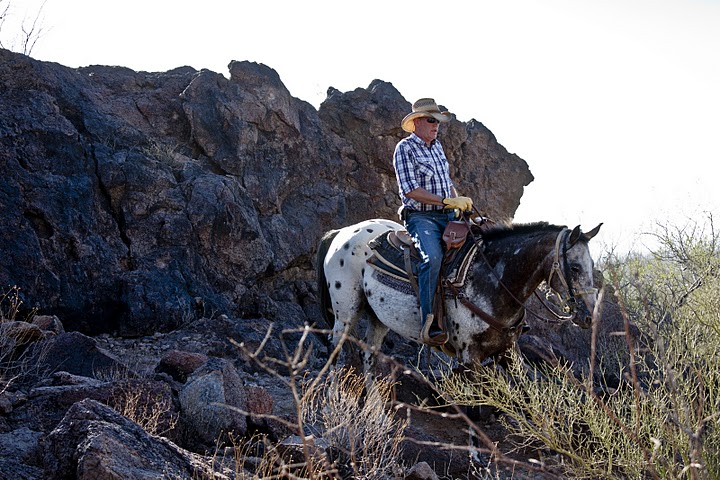Horsemanship 101 - Preparing for your Equestrian Vacation - Part Three
What is your horse trying to tell you?
by Carol Moore
A helpful guide to the meaning behind your horse's behavior
Understanding a little about horse body language makes your first meeting less intimidating. In spite of a horse’s size and mass, he is a very sensitive creature and has lots of emotions going through his mind. Horses, being creatures of habit, are sometimes not given enough credit for their level of intellect. Here are a few common behaviors that are good to understand.

Understanding your horse's body language will help you have a safe and enjoyable trail riding experience. Photo by Laura Holden.
Whinnying or neighing: This is horse conversation. Usually they are calling to someone left behind or out of sight. You will feel the body vibrate when they make this call. Nickering is a softer, shorter version of communication.
Snorting or blowing their nose: This is done to clear the nostril of dust, flying insects, etc., and will also produce a mild body vibration and a sound that is totally natural.
Shaking: After being ridden a while, your horse may develop an itch under the saddle. To relieve this, he will give his body a strong shake that may feel like a little earthquake if you are on his back. This is a normal behavior and nothing to fear.
Ear movement and displays of herd dominance: You can gain a lot of information by watching your horses ears. When they are pricked forward he is curious and watchful. When they are laid flat back, he is annoyed. Usually this gesture will be directed to another horse and it is not a friendly greeting. You will want to direct him away from the horse that he is threatening or being threatened by.Aside from pinning the ears back, horses will also threaten each other by kicking. If you are on a horse that attempts to back into another, he probably intends to kick that horse. You will want to move him away into a less hostile space. It’s a good idea to make your horse mind his own business any time you’re in a group situation.
.jpg)
This horse, with ears laid back, is displaying signs of aggression. Photo by Laura Holden.
.jpg)
Understanding basic horse language will help you assess how your horse is feeling. Ears pricked forward, like on these horses, is a sign of welcome, interest and curiousity. Photo by Laura Holden.
Pawing: Pawing with a front foot is usually done when a horse is getting anxious to do something. He will quit this as soon as you move him around. Pawing in water is just playfulness, however it can lead to him wanting to lie down. A good idea is to get him moving.
Rooting at the bit: When a horse is constantly pulling at the bit, you generally are holding the reins too tight and he is seeking relief from the pressure. Or, it is possible that he is trying to get the reins loosened so that he might eat on the trail. You will have to experiment to see what the cure is. Do not let him eat while being ridden, as this creates an annoying habit.

Keeping a loose rein will release pressure on your horse's mouth and allow him to use his head freely. However, remember not to let your reins get too long! Photo by Laura Holden.
Shying: Watch your horses ears, if he suddenly pricks them up, raises his head and tenses his body, chances are that he has seen something that appears a little scary. Some horses will do nothing more than look and others may react a little more energetically, consisting of a little jump to the side or an attempt to find an escape exit. In either case, when you notice this extra alertness, you’ll want to shorten your reins to have contact with the bit and pay attention until all is calm.
Read the final installment of our Horsemanship 101 series!
About the author:
.jpg)
Carol Moore has been involved in the guest ranch business since 1975 and has aided many beginners with their very first horse back riding experience. Carol is currently employed at the White Stallion Ranch in Tucson, AZ ([url=http://www.whitestallion.com]http://www.whitestallion.com[/url]). She recognized the need for an instructional riding video specifically for the vacation rider and authored the riding video “Which End Does The Hay Go In?” in 1996. This video is used extensively by many ranches as part of their horse orientation program and by lots of prospective guests prior to their ranch visit. For more information, you can e-mail Carol at hoofbeat@theriver.com or visit her web site at www.hoofbeatproductions.com.




